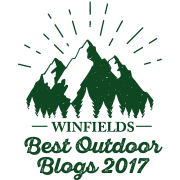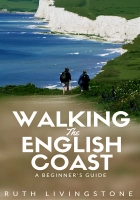It is early September, the tide is out, and Trevone Beach is a bare expanse of sand. On my previous visit in August the incoming tide had forced the crowds to huddle at the apex of the beach. But today I can only see a handful of people strung out along the water’s edge.
I look westwards, across to the Merope Rocks and the lifeboat station. It is always satisfying to scan the route of my last walk and so I spend a few minutes tracing my path across those distant cliffs.
I head along the east side of the bay to Roundhole Point, where I have a spectacular view looking to the east along the craggy coastline.
The walk ahead looks interesting, but not too challenging. It is about five miles to Padstow and I should get there fairly quickly.
 Why is this headland called Roundhole Point? The reason is gaping in front of my feet.
Why is this headland called Roundhole Point? The reason is gaping in front of my feet.
A most enormous round hole.
Too wide to take a decent photograph.
It must be another collapsed cave system, similar to the one I came across yesterday near Dinas Head. But this one is even larger. I am sorry the tide is out, because I would imagine waves come crashing into the base, forming a mini-cauldron.
A Google search reveals a variety of photos, showing what this Round Hole looks like from various angles.
 Onwards. There are some interesting rock formations and I try to work out their names from the map. I am walking above Longcarrow Cove. Ahead I see a rising slope and realise I must be approaching Gunver Head.
Onwards. There are some interesting rock formations and I try to work out their names from the map. I am walking above Longcarrow Cove. Ahead I see a rising slope and realise I must be approaching Gunver Head.
I can’t resist taking this photograph. The rock to the left of the photo is Middle Merope Island. More spectacular is the pointing finger beyond, but this one doesn’t seem to have a name.
The slope up to Gunver head is steep, rising up from a stream at the bottom of a narrow gully and turns out to be the only really strenuous part of today’s walk.
From the top are good views along towards the mouth of Padstow Bay. The South West Coast Path runs along open countryside, next to farmers’ fields.
Somewhere above Butter Cove (delicious name!) I stop and take a photograph looking inland and up the estuary of the River Camel.
Padstow is hidden in the dip behind the slopes on the right. I am making good progress.
 Just past Butter Cove is Pepper Hole, a dramatic feature with the waves washing in and out of a roofless cave.
Just past Butter Cove is Pepper Hole, a dramatic feature with the waves washing in and out of a roofless cave.
The headland that guards the western entrance of Padstow Bay has no prominent name on my map, but I think it is commonly called Stepper Point.
A lighthouse is marked on the cliffs. But all I can see is a tall tower, which I assume is part of an old mine or a leftover structure from the quarry that used to function here.
 When I get nearer to the tower, I still believe it is the remnant of an industrial building.
When I get nearer to the tower, I still believe it is the remnant of an industrial building.
This is, in fact, the lighthouse on my map. It isn’t a proper lighthouse, but a ‘daymark’ tower. I have come across a number of these around the coast. This one was built to guide ships into the Camel estuary but is, of course, only visible during daylight hours.
The daymark tower at Gribben Head, near Fowey, looked far more dramatic with its red and white stripes. This one is so plain, I wonder if anybody notices it.
Coming around the headland, and I look across the bay, assuming the place I can see across the water is Padstow. I believe I am nearly there, not realising that the beach ahead is Hayle Bay and Padstow is tucked some distance up the estuary.
Further round and I realise my mistake. Beaches ahead and no sign of a town. Still a long way to go. Onwards.
Hawkers Cove is quiet and pretty, just a few rows of terraced houses and a little harbour. The tide has come in, covering up The Doom Bar – an extensive sand bank and a hazard to shipping – that sits across the mouth of the bay. [This bank is the reason why the Padstow lifeboat was moved from Hawkers Cove to Mother Ivey’s Bay, back in the 1960’s.]
Beyond Hawker’s Cove is Harbour Cove, and a chance to walk along a beach for a short distance.
I look back towards the mouth of the estuary and I am surprised to see the sky has become dark. A rainstorm? I hope it isn’t coming this way.
I walk over Gun Point and find St George’s Cove below me. I walk down to the sand again and see the beach stretches away up the estuary. To my left the official South West Coast Path follows the top of the low cliffs, but I decide to walk along the sand instead.
The beach is not crowded, but there are several family groups and walkers with dogs. The sand is well-marked with footprints and I make the assumption that I can follow the shore all the way to Padstow.
But, when I round a rocky outcrop, I find the way ahead is covered by water. On the other side of the inlet, a mother is watching her children paddle. I see a cave and a slipway with steps. It seems so near.
I look to see if I can scramble across the rocks, but the cliff rises steeply to my right and there is no safe way around.
The water is only three or four feet deep. What if I carried my rucksack on my head and waded across? But I hate soggy boots. What if I carried my socks and boots on my head too? But then my feet would be wet and sandy on the other side.
Reluctantly I reconcile myself to the inevitable. I turn back. And get a shock.
The sky is an angry shade of dark grey. It is raining over the mouth of Padstow Bay. And the rain is heading this way.
As I retrace my steps I keep looking at the cliffs to my left, hoping for a shortcut route. Surely there must be places I can scramble up and get back on the path? But I don’t see any obvious way.
It is raining heavily by the time I get back to St George’s Cove. All the family groups and other walkers have mysteriously vanished. I follow the track that goes up and over the top of the cliffs, begrudging the wetness, the wasted time and the steep incline.
At the top is a war memorial and, if it wasn’t for the rain, there would be great views across the estuary and Padstow beneath. But it is too wet to take my camera out.
I am meeting my husband over the river at a place called Rock. Dripping wet, I hurry down into Padstow and am relieved the ferry landing-place is easy to find – but disappointed to discover the ferry is an ugly, open boat. Reluctantly, I take my place on wet seats alongside a group of wet passengers.
At the other side I run walk quickly to the nearest (and only) café. It is crowded inside but I find plenty of space on the soggy terrace and treat myself to a pear cider while I wait for hubby to arrive and pick me up.
Miles walked = 6
Total miles = 1,275
Route:





















Enormous Round Hole? Time to buy a wide-angle lens?
What a great idea. I shall put it on my birthday list!
Your husband will only counter with a new bike rack…
Those holes remind me of the larva bubbles we saw in Lanzarote. I wonder if they are formed the same way? What a shame about the tide and the rain.
Lanzarote is a magical place isn’t it? I took our children there many years ago and we loved it. (not very good for beaches, though)
I believe the round hole is formed when the sea wears away a portion of soft rock, forming a cave in the cliff. The cave gradually gets bigger and then the roof collapses, leaving the hole. I think lava bubbles are formed because the exterior of a mass of lava cools and solidifies, but the inside remains molten and drains away. So slightly different mechanism. Similar effect.
Can you help?! I’m trying to find out the inscription on either a stone or bench on the path from the lifeboat station to Mother Iveys – something about toiling all day in the fields – anyone know??
Sorry Simone. Was hoping somebody would reply to you. I might have passed it, but I can’t remember seeing any inscription.
What an ominous sky towards the end of your walk – scary how quickly it can change! The massive holes are worrying too, there should at least be some warning signs. Apparently in 2018 the one at Trevone was the scene of a serious accident to a man (his own fault) who tried to climb down, and also unfortunately the death of a dog which fell down.
Oh, how sad. It was certainly a dramatic section of coastline,
Hi Ruth, hubby and I have been walking the SWCP in small sections since 2017 (before we were married in fact). We have completed Poole – Newquay and are doing Newquay – Padstow this weekend. I discovered your blog early on and we refer to it for both information and entertainment (you are a great writer!) We just wanted to thank you for sharing your accounts. I’m sure our coastal walking is not going to end at Minehead so we will probably be reading your blog for years to come!
Hi Alison. Well done for your progress so far, and hope you have a wonderful weekend. Thank you for your kind words about my blog. I’m sure you won’t stop at Minehead, and do keep in touch. Happy walking!